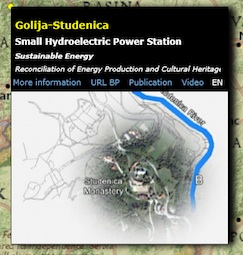Reconciliation of Energy Production and Cultural Heritage Protection.
 Golija-Studenica Biosphere Reserve is situated in south western Serbia and belongs to the inner zone of the Dinaric mountain system. The biosphere reserve includes the Studenica Monastery, which is a cultural World Heritage site and a popular tourist attraction.
Golija-Studenica Biosphere Reserve is situated in south western Serbia and belongs to the inner zone of the Dinaric mountain system. The biosphere reserve includes the Studenica Monastery, which is a cultural World Heritage site and a popular tourist attraction.
The small hydroelectric power station on the Studenica River is built in the immediate surroundings of the Studenica Monastery and supports all electrical needs inside the monastery complex. The project was initiated by monastery authorities in cooperation with the Norwegian government. It may be of interest to note that this initiative originated from a traditional community. This hydroelectric power station is situated on the river, on the grounds of the monastery. This river is renowned for its extremely crystal-clear, cold, non polluted water, which is rich in oxygen and fish species, such as trout and grayling.
This hydroelectric power station is actually a reconstruction of an older one which had been built in the middle of the previous century and had been in working condition for a short time.
Bearing in mind that Studenica is on the World Heritage List, protected by UNESCO and Serbia’s National Law on Cultural Heritage and is situated inside biosphere reserve Golija-Studenica, the construction of the hydroelectric power station on this site has to obey a certain set of regulations; namely, selective and confined usage of natural resources and controlled small scale construction and operations. Due to the strict restrictions and specification of the construction site, the National Agency for Cultural Heritage Protection and Natural Agency for Environmental Protection participated in the planning procedure of this hydroelectric power station and established the key requirement for the construction:
• Environmental and contextual values, i.e. the usage of local materials, the traditional architectural style which corresponds to the style of the complex as a whole, the integration of old and new buildings, especially in regard to the underground infrastructural elements, were to be preserved.
• The penstock was to be completely buried underground in order not to undermine the natural surroundings. The construction was not to reduce the stability of the slope and the surface layer of soil above the construction was to be planted.
• The construction process had to be constantly monitored by archaeologists, materials were not to be prepared on the site and the preparation of concrete and maintenance of machinery were strictly forbidden.
• The underwater ecosystem in the Studenica River is to be preserved at all times.
• During the plant’s construction and afterwards, it has been obligatory to provide thesufficient amount of water flow required by official regulations.
• All the buildings and technical installations were to be built underground if allowed for, and aboveground constructions were to have a ground cover with grass and appropriate vegetation.
• Trees were not to be felled, the terrain morphology was to be protected and preserved, and any kind of vegetation elimination was not allowed.
This hydroelectric power station is an independent system for electricity production and can provide parallel, insular production process independent from the electricity distribution system. The Studenica hydropower plant is one unit headrace type with capacity of 95KW and expected annually output of about 600 MWh/yr.















